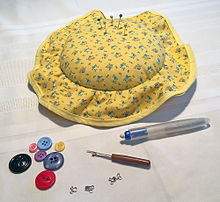Notions (sewing)

In sewing and haberdashery, notions are small objects or accessories, including items that are sewn or otherwise attached to a finished article, such as buttons, snaps, and collar stays. Notions also include the small tools used in sewing, such as needles, thread, pins, marking pens, elastic, and seam rippers. The noun is almost always used in the plural.[1] The term is chiefly in American English (the equivalent British term is haberdashery). It was also formerly used in the phrase "Yankee notions", meaning American products.[2][3][4][5][6] A fabric store will have a section or department devoted to notions, and a spool of thread is considered a notion.
History
[edit]Origins
[edit]The roots of notions trace back around 25,000 years to the discovery of bone needles, a crucial tool in stitching garments made from fur. These early sewers also utilized thimbles to guard against occasional finger pricks, as evidenced by ancient artifacts. The emergence of buttons and buttonholes occurred during the European Crusades, around 500 years later, as Christian armies encountered novel practices in faraway regions. The landscape of sewing changed dramatically with the introduction of machine-made cotton thread in England, approximately half a millennium after the Crusades, facilitating the craft on a global scale.[7]
1700s
[edit]The 18th century stands out as a transformative period for notions. The first sewing needle factory opened in Germany in 1730, and the first mechanical needle was manufactured 25 years later. Although no surviving sewing machine from that era has been discovered, the groundwork for such a device was unmistakably laid.[7]
1800s
[edit]Notions continued to evolve with the prominence of brass buttons as favored fasteners during the War of 1812, spurred by the establishment of the Waterbury Button Company. The subsequent development of twisted cotton thread set the stage for the midcentury invention of the sewing machine. In 1851, Isaac Singer marked a significant milestone by founding the Singer sewing machine empire. Today, antique sewing tools attract collectors due to their rich history and practical utility. Galleries frequently showcase vintage sewing artifacts from diverse corners of the world, providing opportunities to build captivating collections without a substantial financial investment.[7]
As traffic generators in early department stores
[edit]Around 1900, the typical U.S. department store notions department consisted primarily of lace, trimmings, and sewing accessories. It was considered a seasonal business and received little attention. But some stores added accessories to their notions department, which they relocated to the ground floor. Accessories and notions had low price points, low margin, but high volume, and attracted casual shoppers in for a quick purchase. In a 1967 U.S. study, about half of all people in downtown stores bought something in the notions department and 84% of them went on to other departments, of whom almost half bought something else. The quick impulse buy in the notions department "softened up" the shopper and made them more open psychologically to buying things in other parts of the store. Still today, accessories such as costume jewelry and sunglasses are (as well as cosmetics and fragrances) usually placed close to main floor store entrances.[8]
References
[edit]- ^ Both the Oxford English Dictionary and Merriam-Webster's 9th Collegiate Dictionary list this sense as plural only, but The Fashion Dictionary main entry is singular.
- ^ Picken, Mary Brooks, The Fashion Dictionary, Funk and Wagnalls, 1957, p. 235.
- ^ Oxford English Dictionary, "notion, n.", meaning 11
- ^ Hardware Dealers' Magazine. Vol. 25. 1906. p. 472.
There was a time when inventions of this country, especially those of a real meritorious nature, were referred to in foreign countries as "Yankee notions".
- ^ Robert Hendrickson (30 October 2000). The Facts on File Dictionary of American Regionalisms. Infobase. p. 327. ISBN 978-1-4381-2992-1.
Yankee notions: These were originally the mirrors, needles, beads, pocket knives and the like that Yankee sailing ships traded with for native goods
- ^ Merriam Webster's 9th Collegiate Dictionary, under "Notion".
- ^ a b c Rivkin, Mike. "Antiques: A 'notion' for sewing dates back longer than you think". The Desert Sun. Retrieved 16 January 2024.
- ^ Wesley J Stroh. Restructuring Department Store Geographies: The Legacies Of Expansion And Consolidation In Philadelphia’s John Wanamaker And Strawbridge & Clothier, 1860-1960 (Thesis). The Pennsylvania State University The Graduate School College of Earth and Mineral Sciences. p. 101. Retrieved 16 January 2024.
